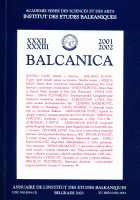Bogorodica bezdinska i versko-politički program patrijarha Arsenija IV Jovanovića
Holy Virgin of Bezdin and Religious and Political Program of Patriarch Arsenije IV Jovanovic
Author(s): Miroslav TimotijevićSubject(s): Fine Arts / Performing Arts
Published by: Balkanološki institut - Srpska akademija nauka i umetnosti
Keywords: Holy Virgin of Bezdin; Patriarch Arsenije IV Jovanovic;
Summary/Abstract: In the very center of baroque Marian religiousness was the reverence for Holy Virgin’s miracles and her miraculous icons. That is why in the churches of Karlovci Metropolitan Diocese, founded after the Great Exodus in 1690, could as well be seen the reverence for a large number of miraculous Holy Virgin icons. The most renowned among them was the miraculous Holy Virgin of Bezdin. This icon, a replica of Holy Virgin Vladimirska, was brought from Kiev by the monk Paysiye Greek (1698–1737) in the spring of 1727. By approval of Metropolitan Mojsej Petrovic, it was temporarily placed in the Belgrade Cathedral Church, and then it was moved to the renovated Vinca monastery. After the Ottoman Turks invaded Serbia again in 1739, the exiled Vinca monks found shelter in the monastery of Bezdin in Banat, taking with them the miraculous icon as well. By orders of the exiled Patriarch of Pec, Arsenije IV Jovanovic, the miraculous icon was secretly taken to Karlovci on 24 March 1743. That was the cause of a lengthy dispute between the Archimandrite of Bezdin, Teodosije Veselinovic, and the Patriarch Arsenije IV Jovanovic. The exiled Patriarch deemed the decision of competent authorities in favor of the monastery not to be effective in the church itself, and refused for the icon to be returned to Bezdin. Instead, it was placed in the Patriarch’s adjoining chapel of St. Trifun (Trifone), which has been called the Holy Virgin Church ever since. A complex cult was developed surrounding the icon, originating from the idea of the miraculous icon as a palladium for the entire ‘Serbian nation’, headed by with the exiled Patriarch of Pec. The meaning and significance of the cult was most logically expressed by the patriarch’s ode to the miraculous icon, which was engraved on the silver plate, mounted on the icon frame (wrought in Vienna in 1745). The adjoining chapel’s master of ceremony was the one in charge of revering the icon and rituals related to it, whose duties were specified by the Instruction issued by the Patriarch on 1 January of the same year.
Journal: BALCANICA
- Issue Year: 2001
- Issue No: 32+33
- Page Range: 311-346
- Page Count: 36
- Language: Serbian

